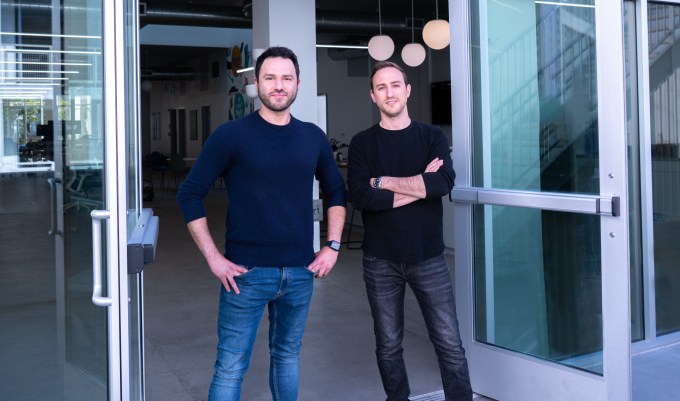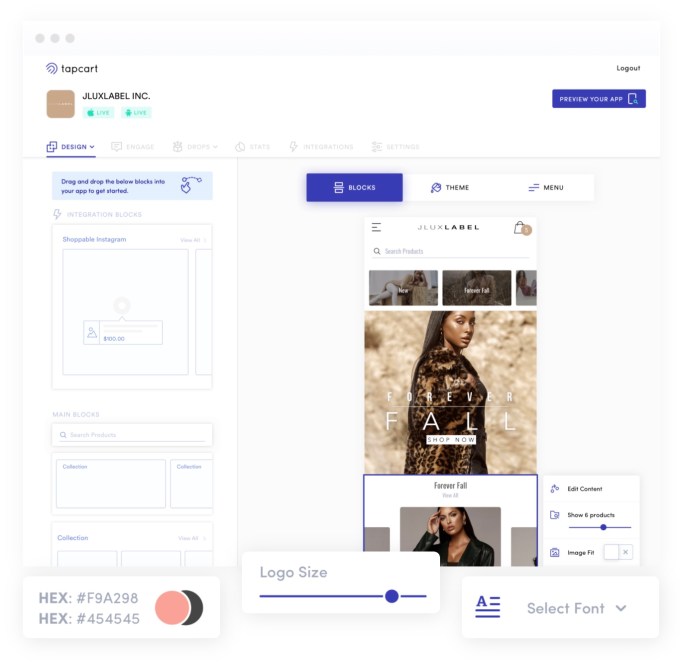Shopify changed the e-commerce landscape by making it easier for merchants to set up their websites both quickly and affordably. A startup called Tapcart is now doing the same for mobile commerce.
The company, which has referred to itself as the “Shopify for mobile apps,” today powers the shopping apps for top brands, including Fashion Nova, Pier One Imports, The Hundreds, Patta, Culture Kings, and thousands more. Following a year of 3x revenue growth, in part driven by the pandemic, Tapcart is today announcing the close of a $50 million round of Series B funding, led by Left Lane Capital. Having clearly taken notice of Tapcart’s traction with its own merchant base, Shopify is among the round’s participants.
Other investors in the round include SignalFire, Greycroft, Act One Ventures and Amplify LA.
Tapcart’s co-founders, Sina Mobasser and Eric Netsch, have worked in the mobile app industry for years. Mobasser’s previous company, TestMax, offered one of the first test prep courses on iOS, while Netsch had more recently worked on the agency side to create mobile and digital experiences for brands. Together, the two realized the potential in helping online merchants bring their businesses to mobile, as easily as they were able to go online with Shopify.

Tapcart’s founders Sina Mobasser and Eric Netsch at their Santa Monica HQ
“Now, you can launch an app on our platform in a matter of weeks, where historically it would take up to a year if you wanted to custom build an app,” explains Mobasser. “And you can do it for a low monthly fee.”
Tapcart’s platform itself offers a simple drag-and-drop builder that allows anyone to create a mobile app for their existing Shopify store using tools to design their layout, customize the product detail pages, integrate checkout options, include product reviews, and even optionally add other branded content, like blogs, lookbooks, videos (including live video) and more. Everything is synced directly from Shopify to the app in real-time, so the merchant’s inventory, products and collections are all kept up-to-date. That’s a big differentiator from some rivals, which require duplicate sets of data and data transformation.
Tapcart, meanwhile, leverages all of Shopify’s APIs and SDKs to create a native application that works with Shopify’s existing data structures.

Image Credits: Tapcart
This tight integration with Shopify helps Tapcart because it doesn’t have to focus on the e-commerce infrastructure, as the way things are structured around inventory and collections are roughly 90% the same across brands. Instead, Tapcart focuses on the 10% that makes brands stand out from one another, which includes things like branding, content and design. Its CMS allows merchants to create exclusive content, change the colors and fonts, add videos and more to make the app look and feel fully customized.
Beyond the mobile app creation aspect to its business, Tapcart also helps merchants automate their marketing. Through the Tapcart platform, merchants can communicate with their customers in real-time using push notifications that can alert them to new sales, to encourage them to return to abandoned carts, or any other promotions. The marketing campaigns can be automated, as well, which helps merchants schedule their upcoming launches and product drops ahead of time. The company claims these push notifications deliver click-through rates that are 72% higher than a traditional email or SMS text because of their interactivity and branding.

Image Credits: Tapcart
The platform has quickly found traction with SMB to mid-market enterprise customers who have reached the stage of their business where it makes sense for them to double down on customer retention and conversion and optimize their mobile workflow.
“Our sweet spot is when you have maybe a couple hundred customers in your database,” notes Netsch. “That’s a perfect time to now focus less on the paid acquisition portion of your business and more on how to retain and engage those existing customers, [so they’ll] shop more and have a better experience,” he says.
During the past 12 months, over $1.2 billion in merchant sales have flowed through Tapcart’s platform. And in 2020, Tapcart’s recurring revenue increased by 3x, as mobile apps grew even faster during the pandemic, which had increased consumer mobile screen time by 20% year-over-year from 2019. Mobile commerce spending also grew 55% year-over-year, topping $53 billion globally during the holiday shopping season, the company says. Tapcart’s own merchants saw mobile app orders at a rate of more than once-per-second during this time, and it believes these trends will continue even as the pandemic comes to an end.
Today, Tapcart generates revenue by charging a flat SaaS (software-as-a-service) fee, which differentiates it from a number of competitors who charge a percent of the merchant’s total sales.

Image Credits: Tapcart
With the additional funding, Tapcart plans to focus on its goal of becoming a vertically integrated mobile commerce suite of tools, which more recently includes support for iOS App Clips. It will also soon release an upgraded version of its insights analytics platform and will offer scripts that merchants can install on their mobile websites to compare what works on the site versus what works in the app.
Later this year, Tapcart plans to launch a full marketing automation product that will allow brands to automate and personalize their notifications even further. And it plans to invest in market expansions to make its product better designed for mobile, global commerce.
The funding will allow Santa Monica-based Tapcart to hire another 200 people over the next 24 months, up from the 70 it has currently. These will include new additions across time zones and even in markets like Australia and Europe as it moves toward global expansion.
Shopify’s investment will open up a number of new opportunities as well, including on product, engineering, business strategy and partnerships. It will also help to get Tapcart in front of Shopify’s 1.7 million global merchants.
“There’s still quite a lot of merchants that need better mobile experiences, but have yet to really double down on the mobile effort and get something like a native app,” notes Netsch. “There’s a lot of different ways and methods that merchants are experimenting with mobile growth, and we’re trying to offer all of the best parts of that in a single platform. So there’s tons of expansion for Tapcart to do just that with the existing target addressable market,” he says.
“We believe brands must be where their customers are, and today that means being on their phones,” said Satish Kanwar, VP of product acceleration at Shopify, in a statement. “Tapcart helps merchants create mobile-first shopping experiences that customers love, reinforcing Shopify’s mission to make commerce better for everyone. We look forward to seeing Tapcart expand its success on Shopify with the more than 1.7 million merchants on our platform today.”
from Startups – TechCrunch https://ift.tt/3jhz3Iu
Comments
Post a Comment